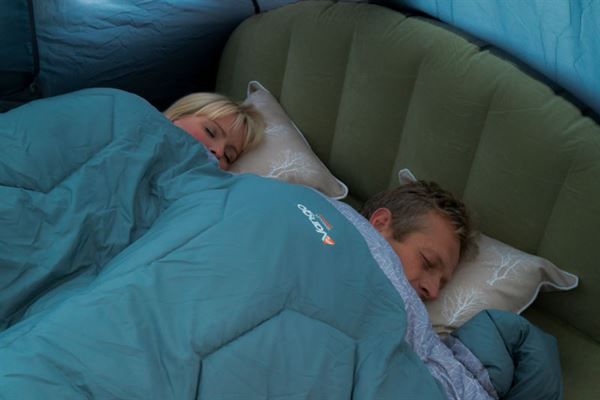Not all camping is done in a huge RV equipped with a bathroom, kitchen and beds. Some traditionalists like to "rough it." This means a tent and not one of those instant pop-up types, although some of these basics apply to those, too.
Before heading out with your tent, make sure it is the appropriate size for the number of people you want to house and that it does not have any tears in it. All tears should be repaired before using the tent.
Advertisement
Choosing a tent location
Choosing a tent location is critical to a worry-free and hopefully somewhat-comfortable camping experience. Before scouting for a site, determine if the area is away from things such as a bear den or a stream that could flood if it rains.
Choosing a tent location is critical to a worry-free and hopefully somewhat-comfortable camping experience. Before scouting for a site, determine if the area is away from things such as a bear den or a stream that could flood if it rains.

TrekTheHorizon
Try to find an area as level as possible. If the area has twigs or a few large rocks, toss them to the side. Find a new spot if the area is very rocky. When you are done clearing the spot, the area should look similar to the one shown in the video below.
Setting up a tent
There are different ways to set up a tent, depending on the type of tent and the manufacturer. The tutorial below provides general guidance for a non-pop-up tent.
There are different ways to set up a tent, depending on the type of tent and the manufacturer. The tutorial below provides general guidance for a non-pop-up tent.

TrekTheHorizon
Place a tarp where you are going to erect the tent. If the tarp sticks out after you put up the tent, tuck the tarp under a little so it doesn't collect rain and funnel it underneath the tent. The video demonstrates how to assemble the poles and how to stake the tent to the ground.
Staking a tent
Some older tents just have a ring on each corner through which to drive a straight stake. Tent manufacturers of newer tents now know that doesn't always keep the stake in place. Most tents come with support straps and angled stakes. Make sure to drive the stake down as far as possible so it's in firm soil.
Some older tents just have a ring on each corner through which to drive a straight stake. Tent manufacturers of newer tents now know that doesn't always keep the stake in place. Most tents come with support straps and angled stakes. Make sure to drive the stake down as far as possible so it's in firm soil.
Staying warm in a tent
Snuggle up! There are several ways to stay warm in a tent, including getting as close to your tent buddy as possible. However, if you're tenting solo or your camping partner(s) is not comfortable with the invasion of personal space, you have other options. An inflatable bed is warmer than sleeping directly on the tent floor, as dirt is cold. Choose insulated sleeping bags or make sure your heavy blankets are tucked under the mattress. A small area rug also can help insulate you from the floor's coldness. Wear a winter hat and socks if it's really cold.
Snuggle up! There are several ways to stay warm in a tent, including getting as close to your tent buddy as possible. However, if you're tenting solo or your camping partner(s) is not comfortable with the invasion of personal space, you have other options. An inflatable bed is warmer than sleeping directly on the tent floor, as dirt is cold. Choose insulated sleeping bags or make sure your heavy blankets are tucked under the mattress. A small area rug also can help insulate you from the floor's coldness. Wear a winter hat and socks if it's really cold.
Packing up a tent
Packing up a tent is as easy as reversing the order in which you put it up, with an added shake to get out any dirt.
Packing up a tent is as easy as reversing the order in which you put it up, with an added shake to get out any dirt.

TrekTheHorizon
After removing the top if you have one, open the tent flap, lift the tent and shake out as much dirt as you can. This prevents sand from being rolled up with the tent. The tutorial shows you how to roll everything -- including the supports -- into one portable log.
Carrying a tent in a backpack
If you're camping by yourself or with one other person and you're trekking, you'll need to carry your supplies on your back -- including your tent.
If you're camping by yourself or with one other person and you're trekking, you'll need to carry your supplies on your back -- including your tent.

TrekTheHorizon
In addition to your tent, you need to somehow fit a flashlight, food, water and a first-aid kit among other things into your backpack. The tutorial below demonstrates the best way to pack these things to most efficiently use limited space.
Tent care tips
Caring for something as you use it makes it last longer. The same is true for tents, especially if they've been subjected to rough conditions outside.
Caring for something as you use it makes it last longer. The same is true for tents, especially if they've been subjected to rough conditions outside.

TrekTheHorizon
A clean picnic table comes in handy when you go to lay out your tent for inspection. After checking and cleaning the supports and stakes, unroll your tent on a clean space. Check all the zippers to make sure they are functioning smoothly. Check for dirt on the fabric -- watch the tutorial to learn how to spot-clean your tent.
Advertisement


